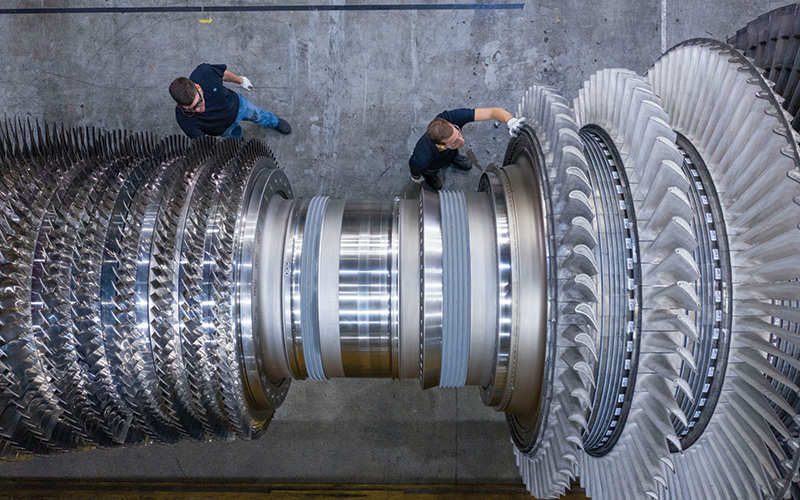Decarbonisation: a holistic approach to the UK's energy system
With UK energy prices at an all-time high and a surge in inflation, access to affordable energy and the wider green transition are both under threat. Our short-term energy security measures must therefore complement our ultimate climate action, says GE Gas Power’s Head of Strategy, Martin O’Neill

Amid an unprecedented energy crisis, gas technologies can play a critical role in the UK’s power mix: not only as a reliable transition technology that helps ensure grid stability by countering the variability of renewables, but also as a sustainable destination technology. The
UK has recognised that its plan for a decarbonised future relies not on a single technology but on a broad and integrated spectrum of multiple lower-carbon-emitting technologies enabled through parallel grid modernisation and investment.
However, deployed technologies must be compatible with long-term climate objectives. With the right investments in low-carbon gases such as hydrogen, and carbon capture, utilisation and storage (CCUS) technologies, gas power generation can progressively decarbonise and support sector electrification, paving a path to 2050.
Strengthening the grid
The UK’s energy grid must prepare for the changes ahead by accelerating physical and digital upgrades to better manage the increase in decentralised renewables. For variable renewables to be truly integrated into power systems, the UK needs to invest in grid improvements. There is a clear need for better efficiency, improved stability and greater interconnectivity of electricity grids.
Market stimulus for future grids and the dispatch of decarbonised assets are imperative to enable the energy transition. With a strong grid backbone, more renewables can be added more quickly.
This holistic approach would ensure that synchronous rotating assets strengthen grids in the near term, and that lower carbon-intensity assets are dispatched ahead of higher carbon-intensity peers.
Getting the regulation right and strengthening energy grids is key. We are all currently grappling with new market dynamics generated by geopolitics. The challenge for industry and electricity generation is to adjust the market design to ensure energy security, affordability and decarbonisation. Accomplishing this simultaneously is no easy objective. To get there, the correct incentives are required to attract investment in the right type of capacity. We need coordinated European regulation and incentive mechanisms to roll out the necessary energy infrastructure quickly and efficiently.
Low-carbon fuels

Breakthrough decarbonisation technologies such as CCUS and hydrogen will be pivotal in unlocking a carbon-neutral future. Against a backdrop of nuclear revival and coal phase-out in the UK and other European countries, massive investments are needed to future-proof the UK’s energy supply.
General Electric (GE) is making progress towards this future-proof approach. Recently, a coal-fired unit project with ORLEN Group in Poland was transformed into a new agreement for the construction of a 745 MW gas-fired power plant, delivering low-carbon power. More than 100 of GE’s gas turbines currently use hydrogen or similar alternative fuels and are able to co-fire natural gas with cleaner fuels, such as hydrogen and biomethane.
We need coordinated European regulation and incentive mechanisms to roll out the necessary energy infrastructure quickly and efficiently
Sector coupling is another crucial component of the UK’s net-zero vision and the build-out of regional decarbonisation blueprints. The East Coast Cluster in the north-east of England is a bold and compelling move. Net Zero Teesside Power – a project sponsored by bp – will help to deliver a ‘just transition’, driving social and economic opportunities in a region that has a proud manufacturing heritage. At the centre of clusters such as Teesside will be access to affordable low-carbon baseload dispatchable electricity generated via a natural gas combined-cycle plant with carbon capture.
Using that power generation plant as the ‘heart’ of the hub, economies of scale will be generated by sharing carbon removal infrastructure so that the lowest-cost transportation and sequestration of captured carbon dioxide back to depleted North Sea wells can be achieved. Imagine – in this decade – the UK could export ‘green’ cement, steel and fertilisers from Teesside. This could drive meaningful growth and employment for industry, the local economy, the region and the UK’s GDP.
Leading the energy transition
GE is uniquely positioned to play a collaborative role in the energy transition, with years of expertise in the industry and complementary technologies, including renewables, gas, nuclear, grid and digital, and a large spectrum of power generation and distribution. When thinking about the future of UK energy, and global energy security, it is important to look at gas turbine technologies not just as a transition technology, but as a sustainable destination technology. While today’s energy security is exacerbated by energy supply disruptions, the UK must act as a leader and catalyst for the global energy transition.
By Martin O’Neill, Head of Strategy, GE Gas Power
Image credit | iStock






Follow us
Advertise
Free e-Newsletter